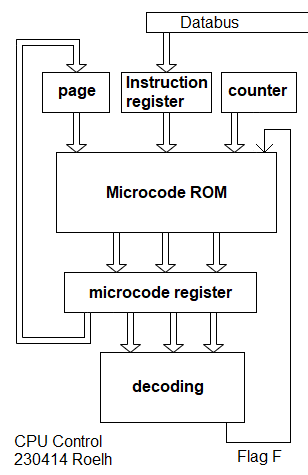The following diagram shows the principle of the control section:

START OF NEW INSTRUCTION
As said before, the processor is controlled by microcode. At the start of a new 6502 or Z80 instruction, the opcode of that instruction will be put in the 8-bit instruction register and the counter will be reset to zero. The counter has 4 bits, so for each opcode in the instruction register there can be a sequence of maximal 16 micro-instructions.
SEQUENCE
The Microcode ROM will deliver the 24-bit micro-instruction and store it in the microcode register at the end of the cycle. At the end of the cycle, the counter is incremented to prepare for fetching the next micro-instruction. In the next cycle, the micro-instruction is decoded (in the decoding block) and the micro-instruction is executed.
For each opcode, there is a unique sequence of micro-instructions that will be executed. At the end of this sequence there is a special micro-instruction called LD_IR that loads the new opcode in the instruction register, resets the counter, and sets the 4-bit page.
PIPELINE
Note that when the micro-instruction is executed, the following micro-instruction is already being looked up in the microcode ROM. This means, that when the decoding section decides that a new opcode must be put in the instruction register, the next micro-instruction is already read from the microcode ROM. So the LD_IR is not the last instruction in the sequence: The micro-instruction that follows LD_IR will also be executed. This is the pipeline effect.
CONDITIONAL EXECUTION
The control unit is capable of conditional execution of micro-instructions. At each location in the microcode ROM, there are actually two instructions stored. Which of these is executed, is determined by a flag called F. If, for a certain instruction, we do not want it to be conditional, we simply store two identical instructions, so in that case it doesn't matter which one is executed.
PAGES
If we would only have 6502 instructions, the page register would not be needed because there are only 256 possible opcodes (of which many are unused). But a Z80 would need several pages, because in its basic set of 256 opcodes there are some that are followed by another opcode byte. It is expected that the Z80 can be handled in 5 pages (A basic page, index IX and index IY page, shift-and-bit page, and the 0xED page for the special Z80 instructions). So of the 16 available pages, 1 will be needed for the 6502 and 5 for the Z80. The page register can be changed by the LD_IR instruction.
Discussions
Become a Hackaday.io Member
Create an account to leave a comment. Already have an account? Log In.